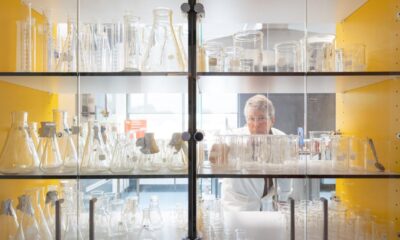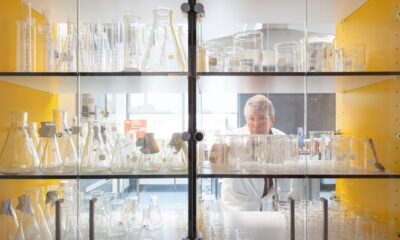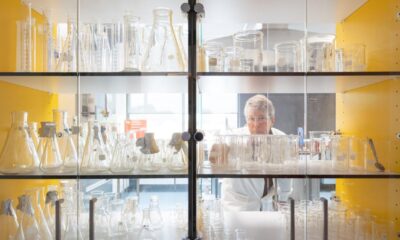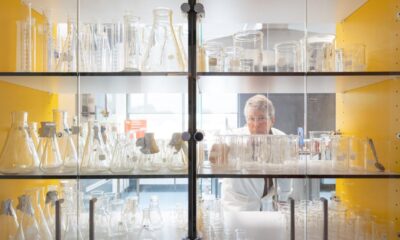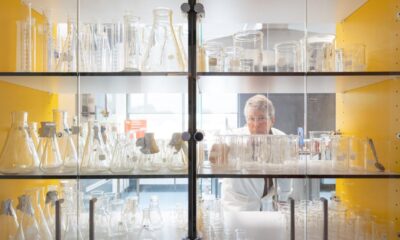Science
Researcher Unlocks Secrets of Heritage Apple Varieties in New Zealand

A significant research initiative is underway at the Jim Dunckley Heritage Orchard in New Zealand, where Aaron Hewson, a master of science student in plant biotechnology, is examining over 300 apple varieties. The orchard, established by the Coastal Otago Branch of the New Zealand Tree Crops Association 25 years ago, is recognized as one of the most diverse collections of apple cultivars in the country. It features unique varieties such as Peasgood Nonsuch, Warner’s King, and Albany Beauty.
Hewson’s research aims to support the preservation and propagation of these heritage cultivars through genetic identification techniques. The apple varieties were originally collected in the 1990s by the late Jim Dunckley, who sourced them from various locations across Otago and Southland, primarily from Clyde, where an old Plant & Food Research orchard was located. Hewson described the collection as a “real kind of hodgepodge mix,” noting that some trees bear names given by local farmers, which may not align with their genetic backgrounds.
“There is one case where we had a Plant & Food apple called Granny Smith, the classic one you get in supermarkets, and another one called Lord Lambourne. These two cultivars should be really different, but the samples were saying they were genetically the same. One of those names has to be wrong,” Hewson explained.
To clarify these discrepancies, samples were collected by university students and staff from the Plant Biochemistry Lab. These samples were labeled, freeze-dried, and sent to a laboratory in France for analysis. This process was facilitated by Plant & Food Research, now part of the Bioeconomy Science Institute. Hewson acknowledged the valuable assistance of his co-supervisor, Dr. Elena Lopez-Girona, during this phase of the research.
The samples underwent genotyping using a SNP chip, which examines approximately 50,000 known DNA hotspots in apple leaves. This technology allows researchers to generate a genetic fingerprint, enabling them to determine whether two trees belong to the same variety or if they are distinct.
Given the stringent biosecurity rules in New Zealand, which complicate the importation of new apple genetics, the local heritage collection could be crucial for enhancing disease resistance and other beneficial traits. Hewson emphasized the importance of genetic diversity, stating, “If we talk about the entire amount of apples across the world, there is something on the order of 10,000 different varieties. But all of our commercial varieties, no matter how many there are, they all come from six apples, so it is really, really narrow.”
According to Associate Professor Lynnette Brownfield from the University of Otago, identifying the genetic makeup of the heritage apple collection will be instrumental for breeders seeking to introduce new genetic material into commercial varieties. This could potentially improve traits such as disease resistance and broaden future breeding options.
The Coastal Otago Branch of the New Zealand Tree Crops Association, which owns the orchard, will determine how to utilize the findings from this research. The ultimate goal is to assign unique identifiers to each tree, providing a comprehensive understanding of the collection and facilitating communication with apple breeders, ranging from backyard growers to organizations like Plant & Food Research.
By exploring the genetic diversity of these heritage apples, Hewson’s work not only seeks to preserve the past but also aims to inform and enhance the future of apple cultivation in New Zealand.
-
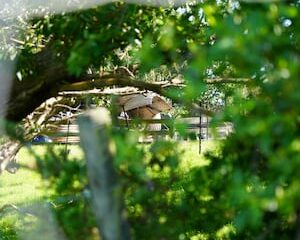
 World1 week ago
World1 week agoPrivate Funeral Held for Dean Field and His Three Children
-
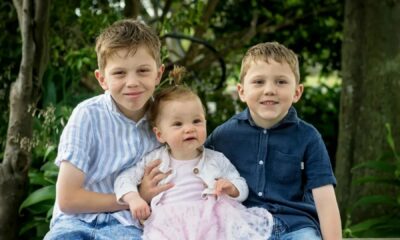
 Top Stories2 weeks ago
Top Stories2 weeks agoFuneral Planned for Field Siblings After Tragic House Fire
-

 Sports3 months ago
Sports3 months agoNetball New Zealand Stands Down Dame Noeline Taurua for Series
-

 Entertainment3 months ago
Entertainment3 months agoTributes Pour In for Lachlan Rofe, Reality Star, Dead at 47
-

 Entertainment2 months ago
Entertainment2 months agoNew ‘Maverick’ Chaser Joins Beat the Chasers Season Finale
-

 Sports3 months ago
Sports3 months agoSilver Ferns Legend Laura Langman Criticizes Team’s Attitude
-

 Sports1 month ago
Sports1 month agoEli Katoa Rushed to Hospital After Sideline Incident During Match
-

 World2 weeks ago
World2 weeks agoInvestigation Underway in Tragic Sanson House Fire Involving Family
-

 Politics2 months ago
Politics2 months agoNetball NZ Calls for Respect Amid Dame Taurua’s Standoff
-

 Top Stories2 weeks ago
Top Stories2 weeks agoShock and Grief Follow Tragic Family Deaths in New Zealand
-

 Entertainment3 months ago
Entertainment3 months agoKhloe Kardashian Embraces Innovative Stem Cell Therapy in Mexico
-

 World4 months ago
World4 months agoPolice Arrest Multiple Individuals During Funeral for Zain Taikato-Fox



